Humming Blog |
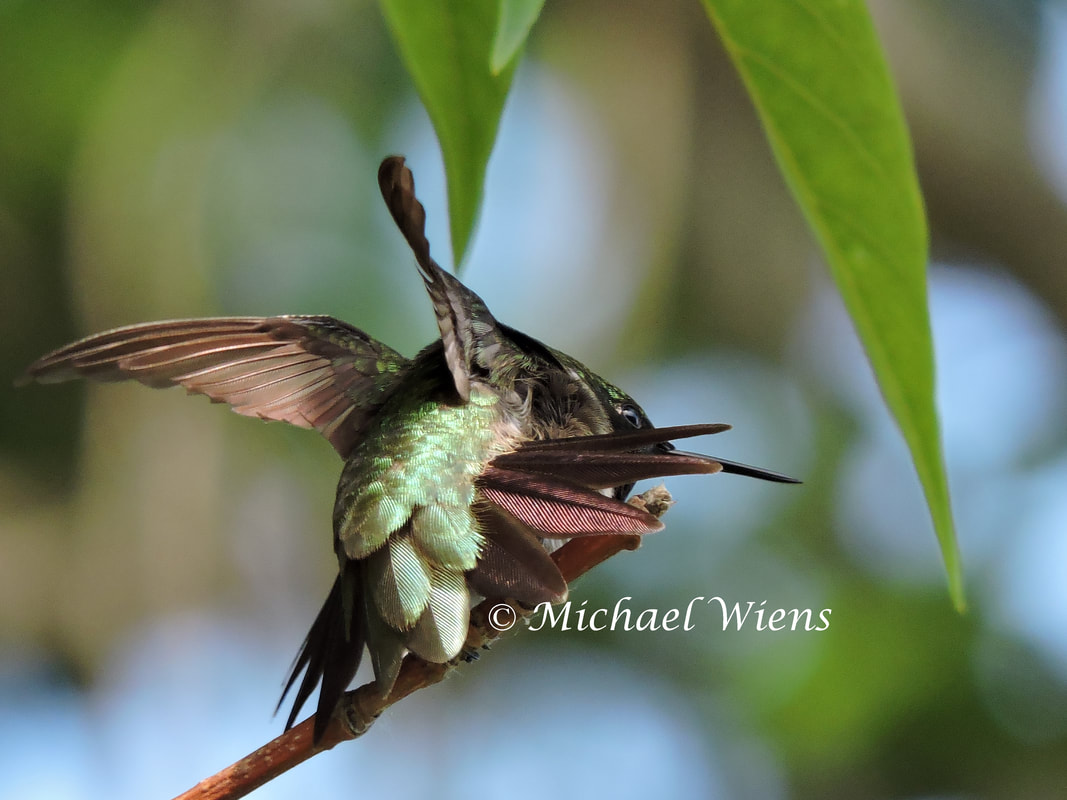 Without knowing the number of strokes of the wing, the miles traveled, the continent's covered, year after year, it's difficult to understand just how brilliantly designed hummingbirds really are. There is power in the muscles, tendons and joints of the wings that would make any engineer's jaw drop. We just can't possibly imagine what kind of design went into creating the married fibers of every individual feather that can withstand the powerful drumming of the wings millions upon millions of times, with very little wear. The mobility of those joints and wings allow for the most incredible and unusual movements for a hummingbird to fly in any direction, and to withstand some of the most fierce battles. Instant power up, in the blink of an eye, puts an enormous amount of stress on those shoulder muscles, but never seem to break down. This just covers a very small but complex piece of the design of hummingbird, without getting into every other magnificent part of their design. They are incredible in so many ways, and impossible to explain in any. After a short rest, Ziggy, the adult male Ruby-throat hummingbird, stretches his wings, and gets ready to move on to another location of the garden to stand patrol. June 14, 2019. North east of Edmonton, Alberta, Canada.
0 Comments
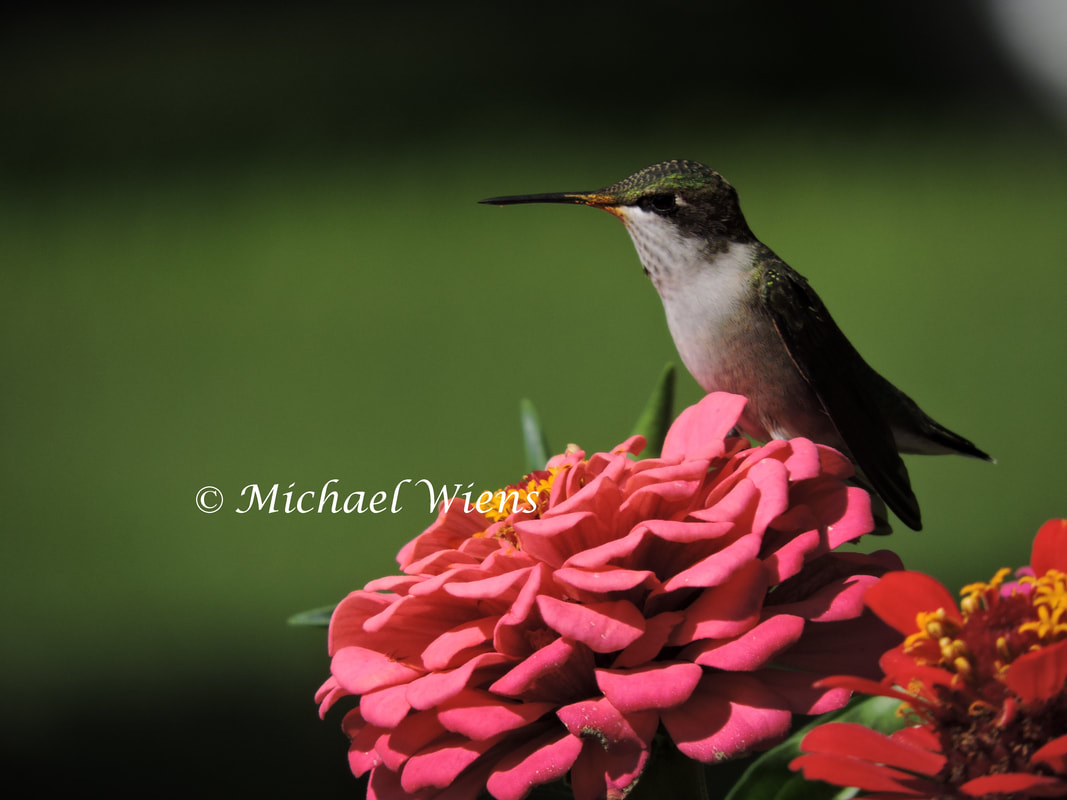 Like a child with a spoon, young hummingbirds can be just as clumsy while eating. Food can end up all over their head and all over their bill. This youngster reveals his age from the pollen pasted on his face, and the spot he chose to perch. This boy, named "freckle", shows the dark spots coming in on his throat, while one red feather shows the bling in the right light conditions, as seen in the second image. For anyone who grows Zinnia flowers, you know just how frequently hummingbirds use them as a perch. I always consider Zinnia flowers an essential flower for young hummingbirds. I think of them as a training flower. They're a large target with brilliant colors and an easy access to the pollen filled button. August 10, 2019. Northeast of Edmonton, Alberta, Canada. 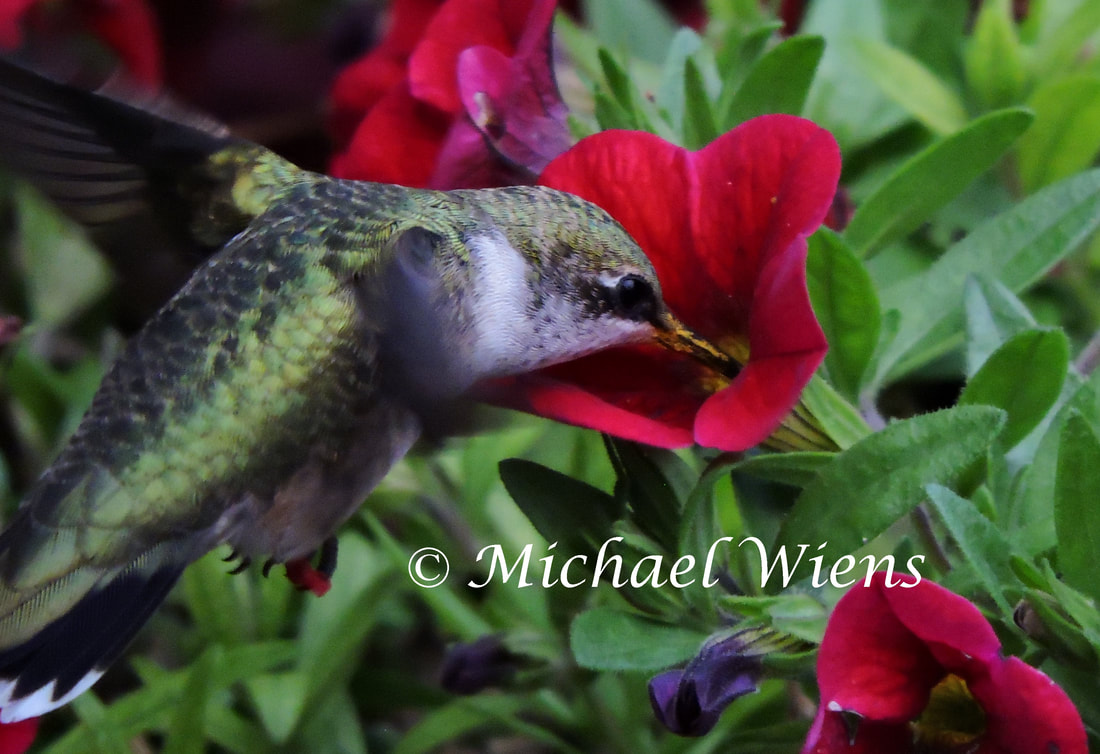 With swift movements they can be just a blur, and unless they're sitting still, they can be very difficult to identify. So here are few things to watch for, so you will be able to differentiate the young from the adults. Just know that it doesn't take long for the young birds to behave like the adults, and don't think that you'll be able to tell them apart by size because the young hummingbirds will be very similar in size to the adults. 1. The most obvious is appearance, but even that can be difficult at times. Adult Males are typically smaller than the females. Their bill is a finer point, the wings are shorter, and when the tail is fanned out it has no white, but more sharply pointed. The most obvious is the RUBY throat, or appearing dark black without light reflection. The younger birds can appear the same size as the adult female, except in tail and bill length, but those grow to full length in days. It doesn't take long before spots start appearing on the throat of the young males. Those spots of black usually come in quite consistently, but the red feathers soon to follow, are very inconsistent, with oftentimes just one red bling at a time. 2. Watch their behavior - Young birds will be clumsy. They can oftentimes be seen slapping around in the flowers, making noises as their wings slap the flower petals. The young birds will use their feet a lot in feeding. They grip and grab anything to get good leverage on the flower they pursue. In this image, you can see shredded flower petals still pierced by his little talons. Young hummingbirds will spend a much longer time in the flowers before resting. Adult birds will spend much less time in the flowers, unless that's all that's available. They will usually taste and sample, but rest for more, and choose feeders far more. Adult hummingbirds will avoid awkward situations in the flowers. They'll select the ones that require the least amount of effort, and the ones most exposed. 3. Feeding from feeders - I've had so many people tell me that their hummingbirds don't like hummingbird feeders. First of all I must say that there isn't a single hummingbird on this planet that won't like a feeder, once it realizes what's in it. These occurrences are usually well after they've arrived, mated, and nested. It's always the young birds that go through the learning process of a feeder. They will spend the next week, after leaving the nest, sampling, experimenting, unable to resist their curiosity. They will literally spot every red object in sight, and often time fly right up to a feeder to examine the beautiful colors, and then turn away. Eventually they will learn from another young bird that's already solve them, or from the behavior of an adult male who spends the majority of his time defending that feeder. But they will learn, and when they do, life will never be the same. They will discover the value of that endless nectar, and not be able to resist the urge of addiction. They will soon fight like the rest, oftentimes showing bald patches and body scars, but knowing it is worth the effort. August 9, 2019. N.E. of Edmonton, Alberta, Canada. Young male Ruby-throat hummingbird, feeding from a patch of Million Bells(Calibrachoa). 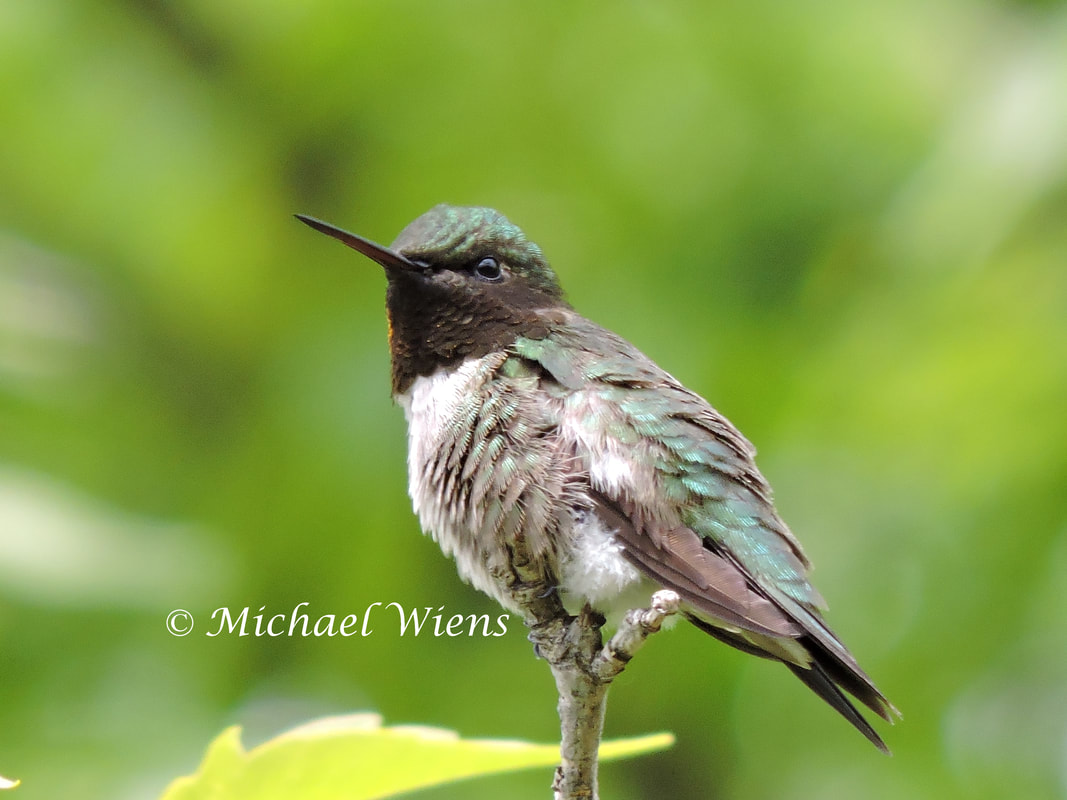 Even though difficult times are upon us, it certainly gives us time to appreciate the simple things in life, and while many people are forced to stay home, it gives plenty of opportunity to enjoy the arrival of hummingbirds. The southeast portion of the United States is now receiving their first hummingbirds, while 2 feet of snow still blankets my region. I don't know if Ziggy is still around, or if one of his many offspring will take over with their own legacy. Each Spring has its own surprises, and each first arrival is unforgettable. Last year Ziggy moved like a missile past me, perched on a branch, and then flew to his fountain. Each day I wait and wonder about his arrival. Will he recognize me, will he put on a show, or will it be another hummingbird that takes his place and has his own antics? This image is of Ziggy. Every season he gave me countless opportunities to photograph him. It was rare for him to be gone from a yard for any length of time beyond 30 minutes. I could step outside, sit down and look around, and within no time at all I'd spot him on one of his favorite perches. Adult male Ruby throat hummingbird, June 8, 2019. North east of Edmonton, Alberta, Canada. 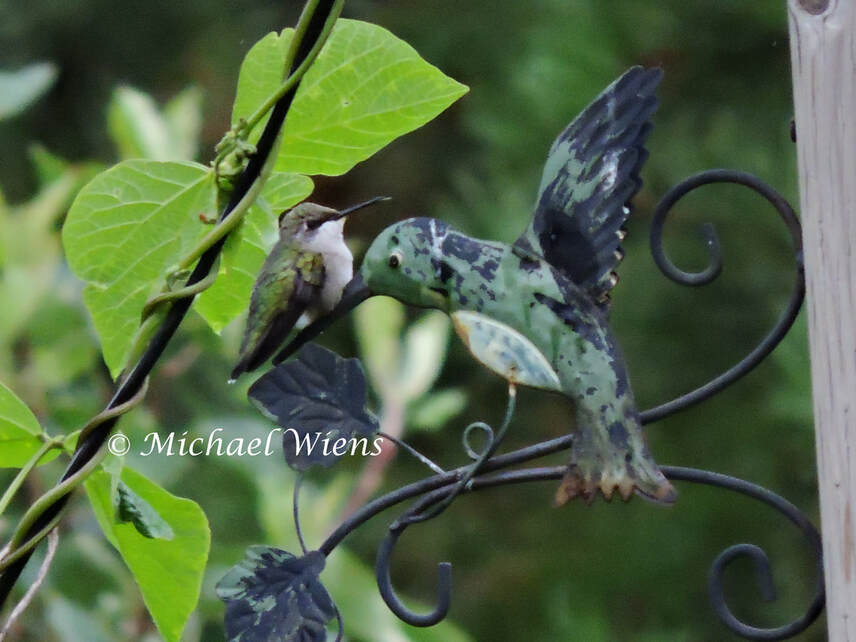 Young hummingbirds don't take long before they develop the courage to fiercely interact with the adults. They need to learn quickly, and develop skills necessary to fight and defend territory. Since hummingbirds typically only have 2 young at a time, their population doesn't multiply as quickly as other birds, but since they also develop skills much quicker than other birds, they have a bit less to worry about in being captured by predators. Within one week of leaving the nest, juvenile hummingbirds develop unbelievable speed and agility, being able to compete with the best of them. They are picked on by the adults soon after leaving the nest, and what seems like cruel behavior, soon reveals the real intentions as the young quickly learn to defend themselves. Tough love couldn't be displayed in any species better than in hummingbirds. This young Ruby-throat was part of a joint effort with another young Ruby. One juvie showed up and was immediately chased into the sky, through the trees, and around the county. While this was happening, this youngster showed up at the feeder directly above where it's perched. It guzzled up as much nectar as possible and then perched below in a well camouflaged spot, under a canopy of leaves on a very unsuspecting perch. The dominant male of this particular feeder returned, but had no idea of the trouble maker only five feet below him. Juvenile Ruby-throat hummingbird. August 9, 2019. N.E. of Edmonton, Alberta, Canada. 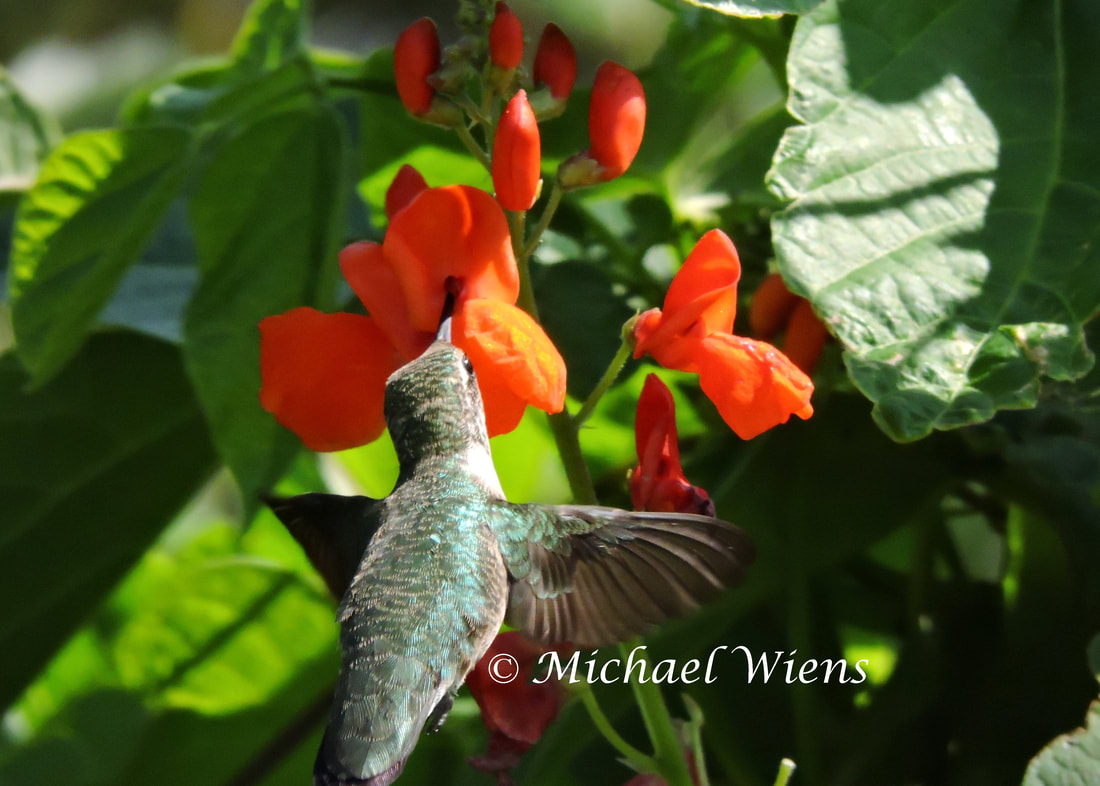 So many plants require a very long growing season from seed to maturity, and many require a head start indoors before planting outdoors in order to have them flower in that season. But for those that don't have the time to start seeds indoors, there is an option with a few plants. If you don't have the time to start indoors weeks ahead of time, remember a couple plants that you can direct plant, that grow very quickly, and will be flowering well before the time young hummingbirds leave the nest. Scarlet Runners are a fantastic, fast growing plant that always attract young hummingbirds, as well as some of the adults. They vine very quickly, and given a decent soil, will produce an abundance of blooms. Full sun will produce blooms right through the season. Vining Nasturtiums are another favorite of mine that can be directly planted, will grow rapidly, and product an abundance of nectar filled flowers that always attract the young hummingbirds. 50 to 75 percent sun is perfect for these plants. More sun will produce more blooms, but they'll start to yellow and die off earlier. With both of these plants, remember to plant them about 7 days before the last frost. They will germinate in about 10 to 14 days. They will bloom in about 50 to 60 days from the time they're planted and then produce an abundance of seeds for the following season. Last season I had these 2 plants growing all over the place. Wherever I had a feeder pole, trellis, or open soil, I planted these seeds. They produced well, and every single bloom was visited by the young hummingbirds. If you don't have time this season to start indoor seeding, keep these two valuable plants in mind. They require very little attention, and produce very well. Juvenile male Ruby-throat hummingbirds feeding from Scarlet Runners, and Vining Nasturtiums. N.E. of Edmonton, Alberta, Canada. August 8, 2019. 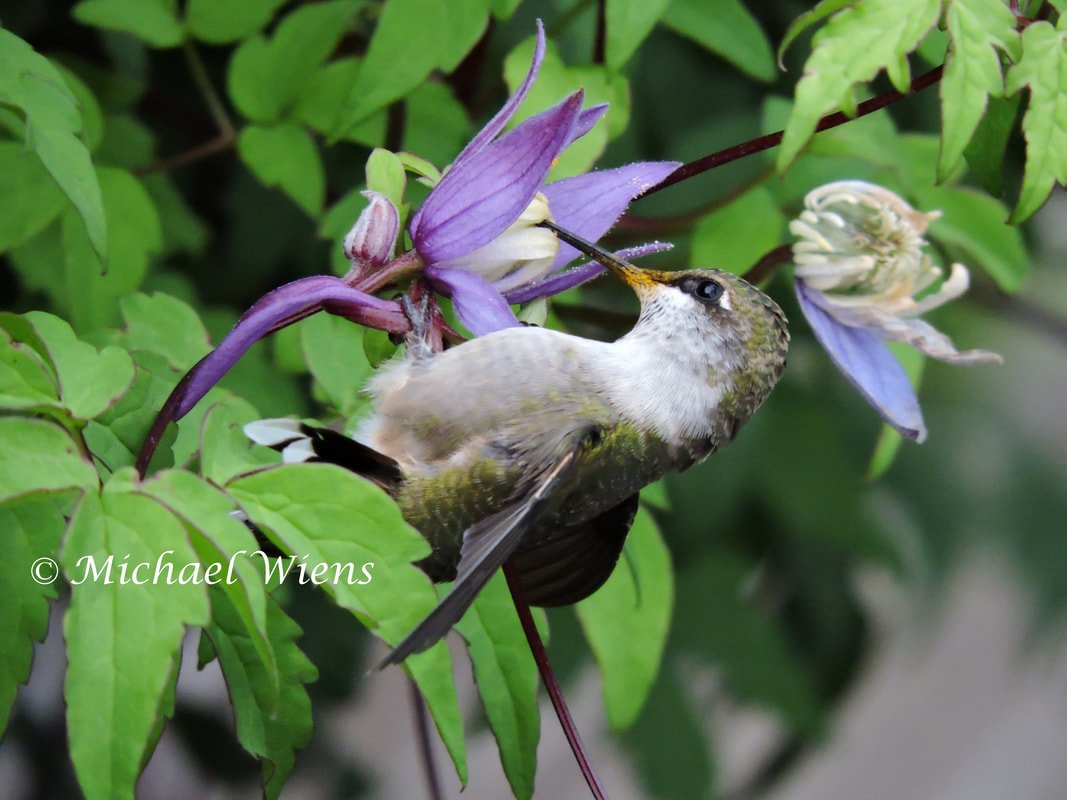 We start to sow seeds in January, and water twice a day. We watch and care for the growing seedlings, thinning, weeding and nurturing them until mature. We till up gardens, spread mulch, fertilize, and watch our plants grow. We spend an enormous amount of time and money creating a garden, not like the rest, but overdoing it to the extremes. Then we wait. We watch with excitement, sometimes days on end without even a glimmer of hope. Sadness can set it, but it doesn't stop us from watching and waiting. Then it happens! A swift movement and a flash of feathers! Could it be? Our hearts race, and our eyes focus. Am I sure it was a hummingbird? We start to over think it, and question ourselves. We wait and wonder for a second sign of proof. Sure enough! He arrives at the feeder, and our fears disappear. He arrived! He made it through unthinkable dangers and distances throughout the year. He traveled from an entirely different continent just to make it home. We work, wonder, worry, and wait every year just to see our tiny little friends return. It's not just an interest we have, or a hobby like the rest. It's an investment that requires long term dedication. It's not a job or a chore, but a long term commitment. It's not something that can be easily explained to a friend or family member. Ultimately, it's a joy that keeps us interested for months, and invested for years. It's captures like this that push us to doing what we do. That moment, imprinted in our mind, is a piece of nature that we witnessed, rare and unforgettable! Simply put, it's what we do! Juvenile Ruby-throat giving his best effort to get every last bit of nectar from a Bluebird Clematis. August 9, 2019. N.E. of Edmonton, Alberta, Canada. 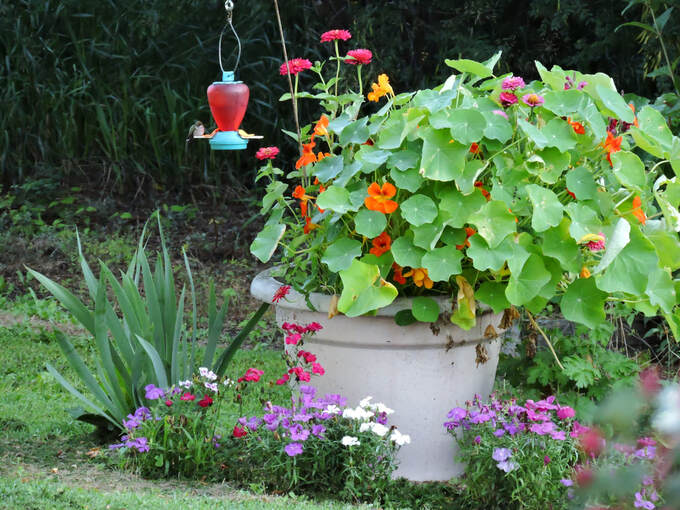 Imagine a unique hour glass with a selected amount of time. Flip it over and know that when it runs out, there is no more time remaining, and no way to reset it. It is finished! This is similar to the hummingbird metabolism. They are very limited in time between feedings. Large gaps or distances between feeding times can be fatal. They have a metabolism faster than most things on this planet, and that's what makes them unique. They can go into a state of torpor(mini-hibernation) in cold weather cycles, but in normal conditions they need to feed frequently. This is the reason they feed in patterns that require the least amount of energy. They will NOT return to a garden that has a very limited source of food, especially if it requires too much energy to get to that location. Make it worth their while! If you are planning a hummingbird garden, give them very good reason to return. Don't just fill a single planter and expect great results. Plant clusters around your garden! Search out their favorite flowers in your region, plant them heavily, and if you have the space, create targets large enough to get their attention. If you can have a hummingbird feed for several minutes around your garden, you can be sure it's gaining the required amount of fuel from that nectar to keep it returning. If you have a hummingbird flash feed for just seconds and then it leaves, it's already figured out that there's little reason to stick around. A typical hummingbird, under normal conditions will feed every 10 to 20 minutes on average. A hummingbird will feed from a feeder for 30 - 60 seconds on average. A hummingbird will feed from flowers for at least that amount of time, and even more, because it requires a longer time to extract the same amount of nectar from flowers. Cold weather they slow down, and likewise in very hot weather. Keep this in mind, and know that a hummingbird will not fly 10 minutes out of its way to get a very limited amount of nectar from a small pot of flowers. Give them a smorgasbord of their favorites, and plug your garden full of them. You will not regret it come the time young are leaving the nest. Because young hummingbirds take a bit of time to learn feeders, place one near each large cluster of flowers. You may find that young hummingbirds notice it because of the color, and then reject it. This does NOT mean they don't like feeders. It means they don't know them, YET! Give them time, and your islands of flowers will keep them returning until they gather up the courage to stick their bill into the life changing feeders. Aug 10, 2019. N.E. of Edmonton, Alberta, Canada. 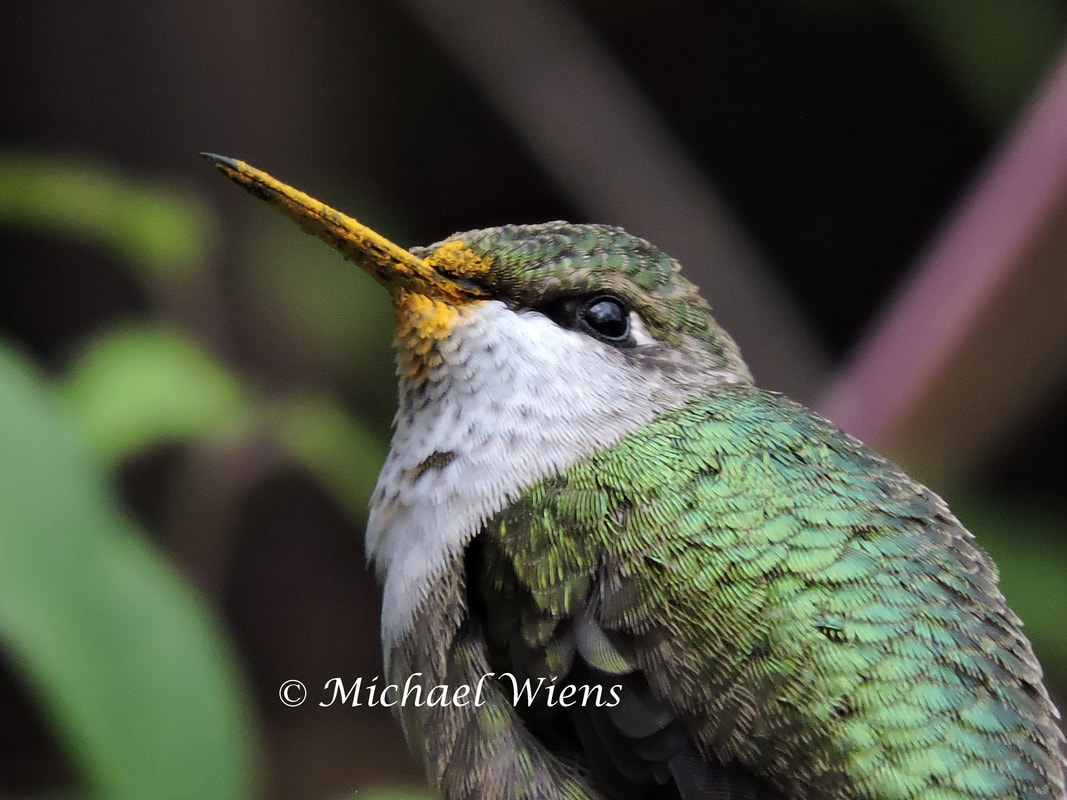
As the Ruby-throats start moving north across the Eastern half of the United States, they'll be searching for fuel to keep their high octane systems moving. That fuel is found in flowers and feeders, which both provide primarily sucrose. Some people feel guilt in giving hummingbirds something that they can find in flowers, but 70 years or more of nectar feeders have proven that our efforts in feeding them hasn't hindered their existence. The reality is that hummingbirds are much like other living things. They'll search out all sources of food and then choose the one that requires the least amount of effort. What this does is stop them from expending a lot of energy in searching out food sources that may be very limited or non-existent in many areas. Our help hasn't hindered them, but allowed them to flourish over the past several decades.
As the birds move north, these mature birds now know plenty to recognize the value of a feeder filled with sweet fuel. So if you are wondering which is better to attract hummingbirds, remember feeders before flowers. Adult birds will spot a feeder across a field, like a starving man will spot the golden arches across the desert. Feeders are a MUST in Spring. Flowers are a MUST in Summer. Later in the season when young leave the nest, flowers are necessary as they know nothing more than their instinctive attraction to naturally looking flowers. Those flowers in mass amounts will keep the young around long enough to learn what the mature birds have been protecting from them, feeders. So don't be overly concerned about a lack of flowers in your garden as they're moving north, and don't feel guilty about providing an abundance of feeders, but rather spend your efforts in building up a blast of color for when the young leave the nest. Time and maturity will determine when the young graduate from primarily flowers to a mixed diet. This youngster got a bit carried away in the pollen, and had a serious case of sugar overload. August 9, 2019. N.E. of Edmonton, Alberta, Canada. 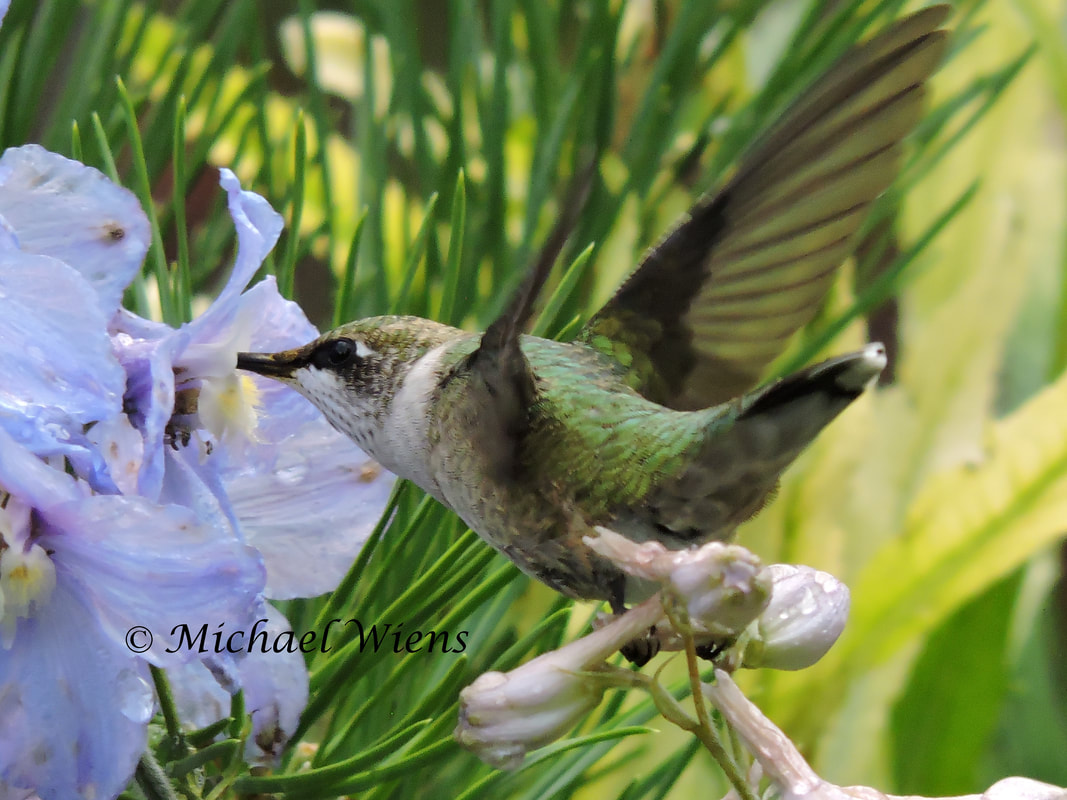
My favorite time in the hummingbird season is when the young birds first leave the nest. Most don't immediately go to feeders because they don't look that natural, and they take a bit of time to learn, or they'll mimic the birds that already know them. So for the first 7 - 14 days after they leave the nest, flower feeding is the best time to capture the young hummingbirds fumbling around in the flowers. Just as all young in every species have really playful tendencies, it's the same with young hummingbirds. Fear in their minds doesn't exist yet. It needs to be learned as they encounter predators. So they do what all young do - they play, chase, and fumble around in the flowers with very little attention to what's going on around them. They can often times get themselves tangled up in awkward situations. Ungraceful feeding is often times a very clear way to identify a young bird. Adults will go to the flowers openly exposed, and avoid the ones that can get them in serious trouble.
I sat in an area of our garden, rich with Delphiniums, and waited for things to begin. After a few minutes of sitting still, the hummingbird movement began. They started to dance around in the Delphinium patch that was soaked in rain drops from the night before. I gathered up as many captures as possible. It was only after the fact that I noticed the tiny talons firmly gripped onto the tail end of the flower while he tried to reach the nectar. Juvenile male Ruby-throat hummingbird. N.E. of Edmonton, Alberta, Canada. August 8, 2019. |
Archives
June 2024
Categories
All
|
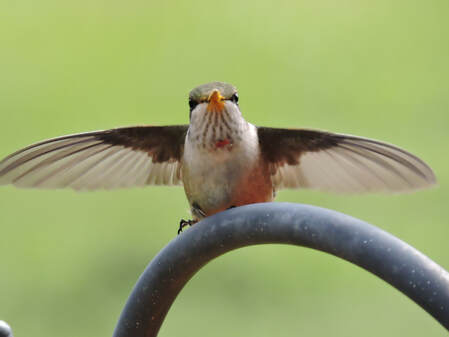
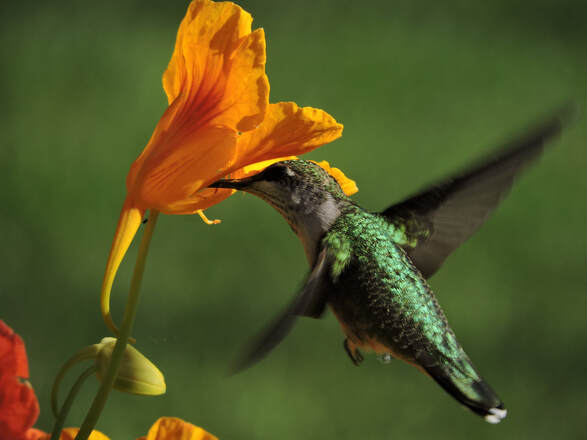
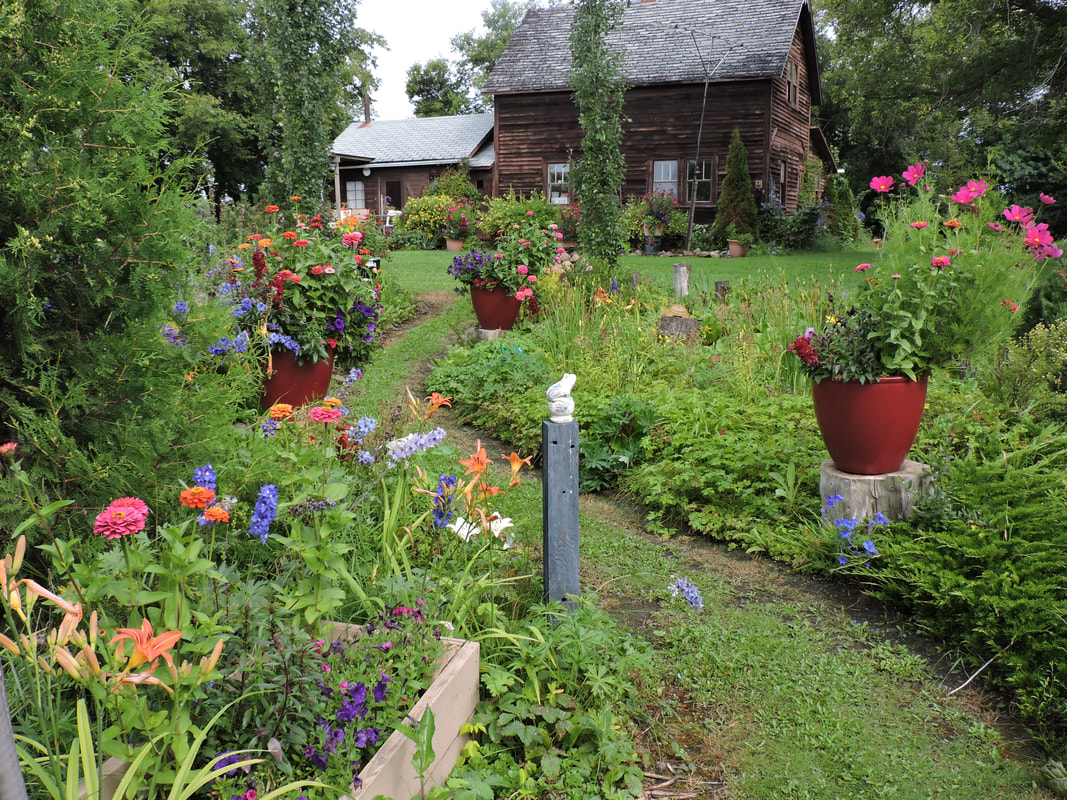
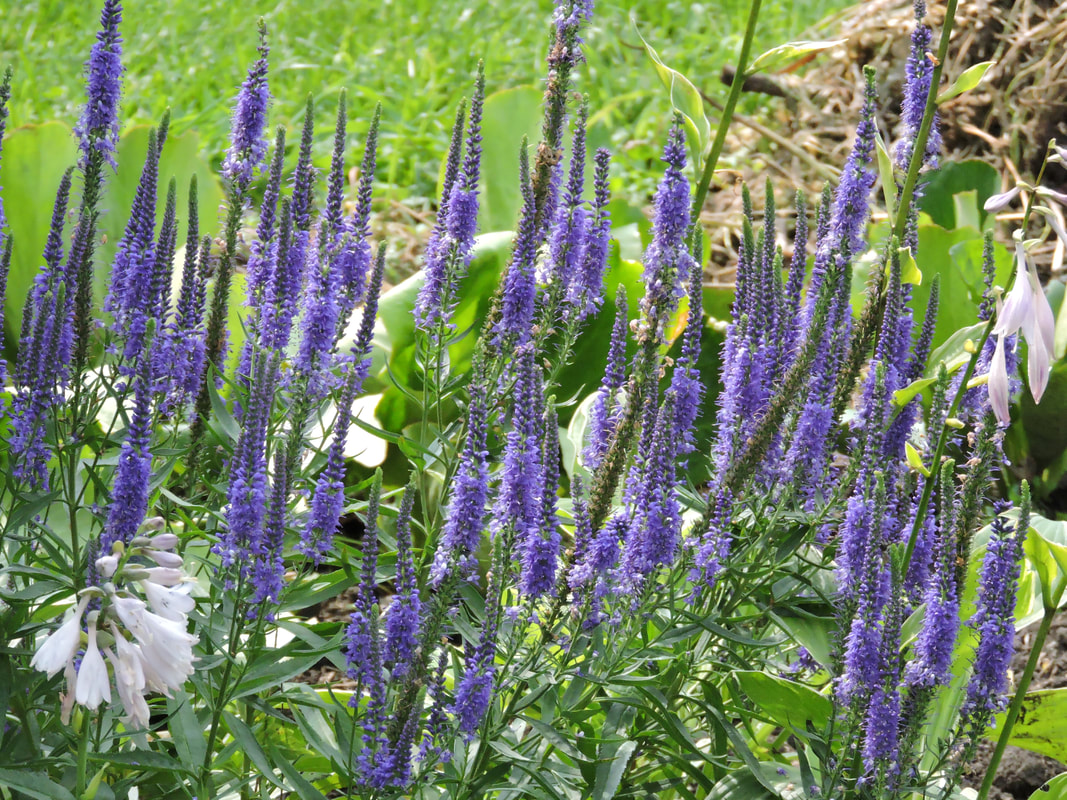
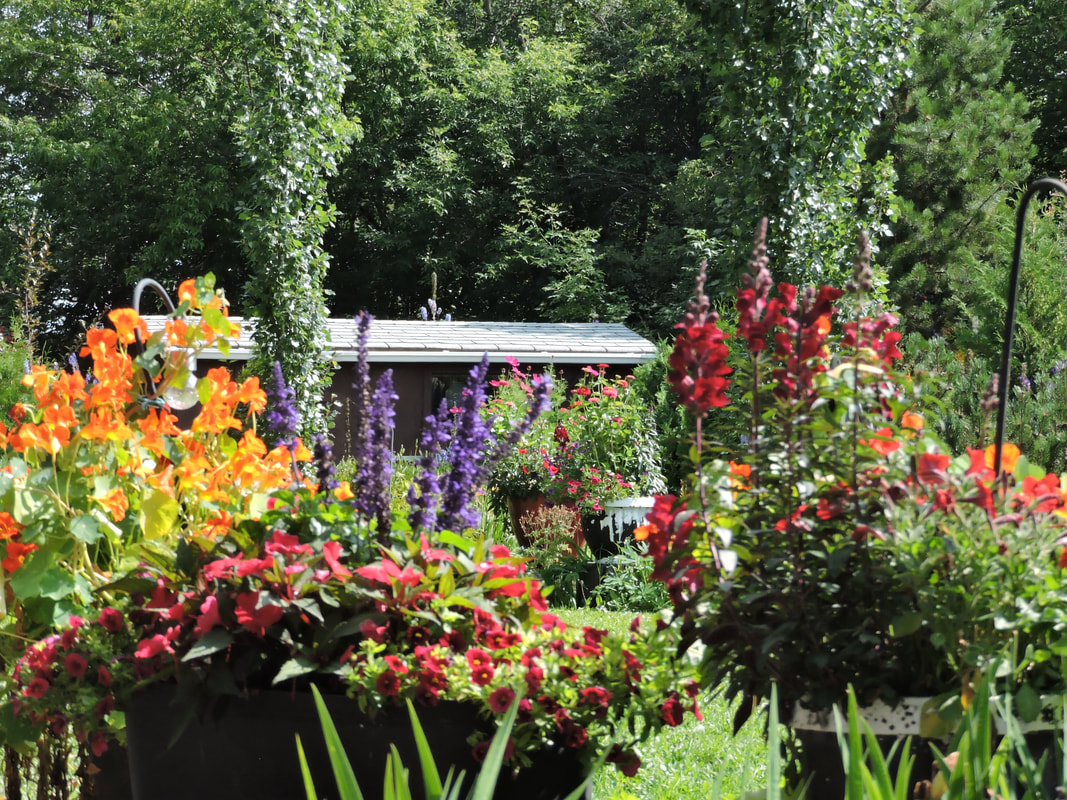
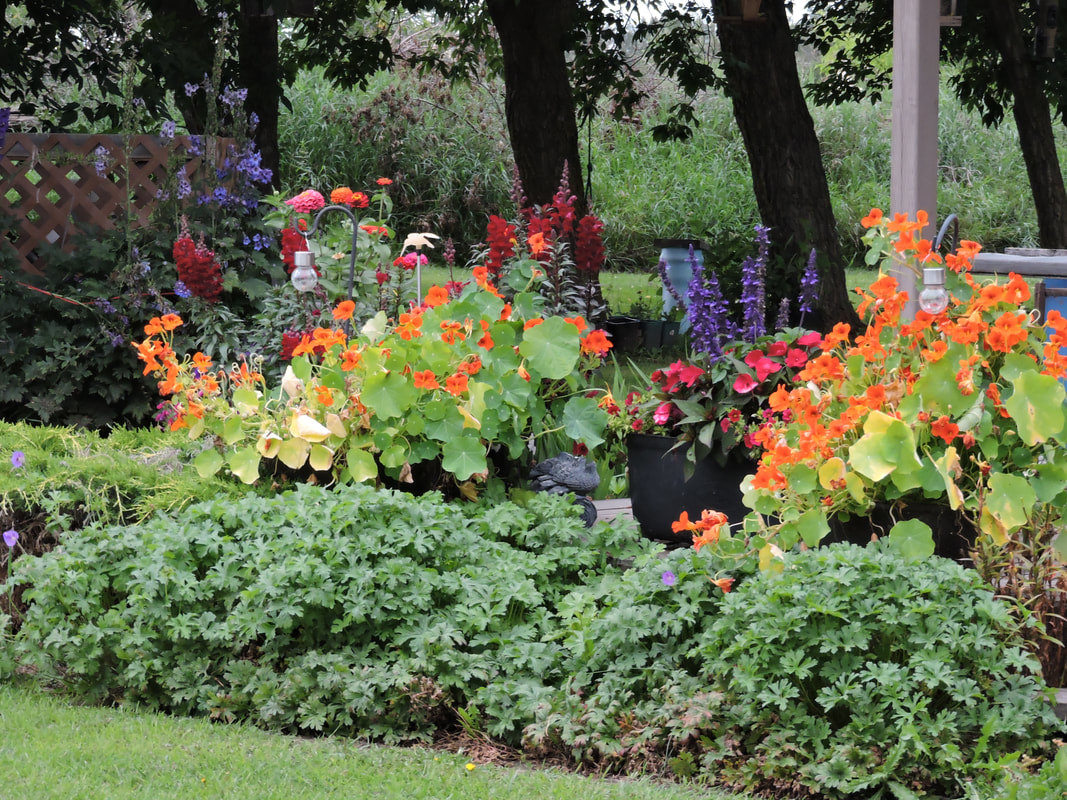
 RSS Feed
RSS Feed
